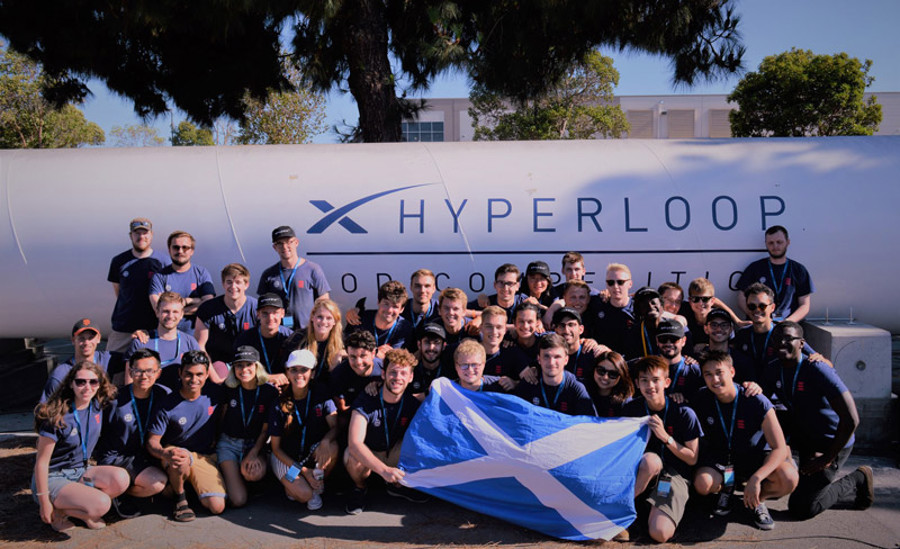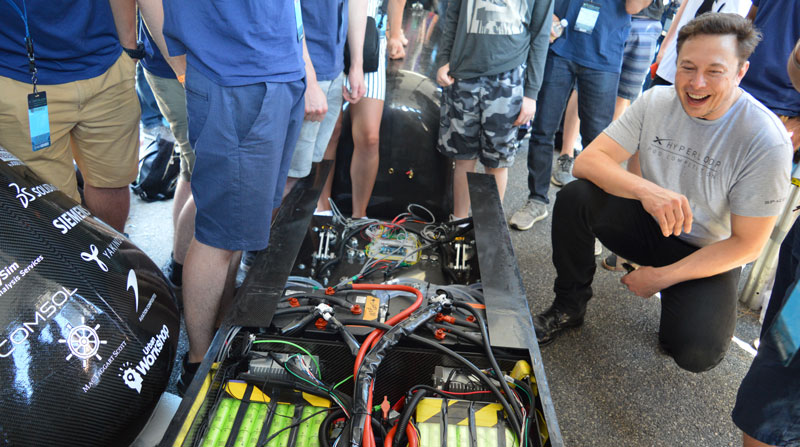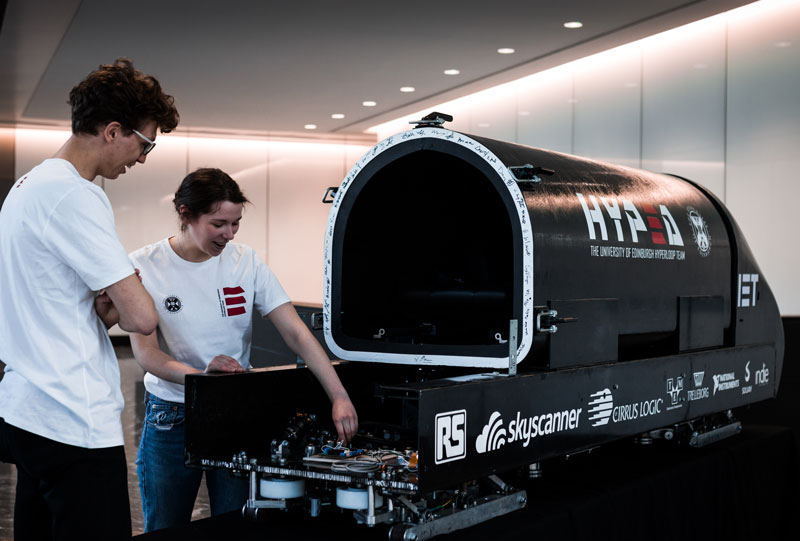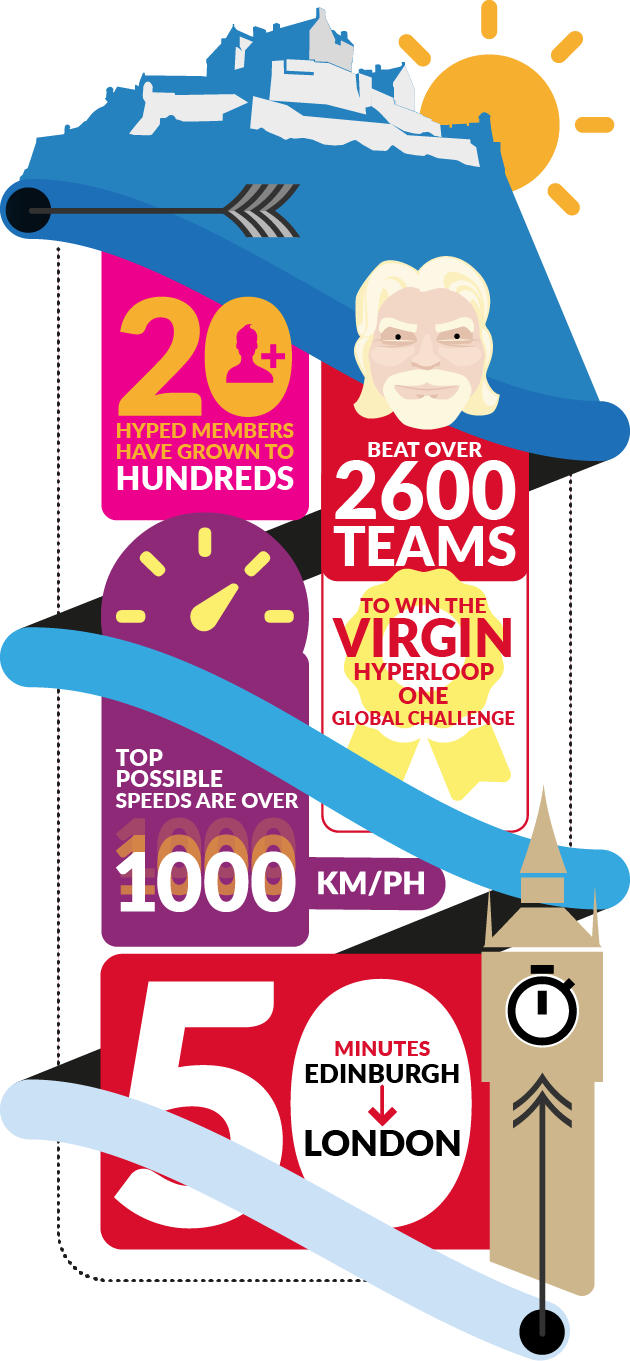
To whet your appetite for the first event in our new series of free public lectures, we look at the exciting story of HYPED – the Edinburgh University team who are among those battling to bring Elon Musk's futuristic vision of transit closer to reality.
Imagine it. Edinburgh, 2040. You’ve got a meeting in London this morning. You decide to walk to the station, because despite the presence of self-driving cars, an extensive charging network and smart roads, Edinburgh remains one of the UK’s most walkable cities – and subsequently free of congestion. On your way, you glance at several vertical allotments adorning the side of office blocks, and rows of solar-powered diodes where orange streetlights used to stand. They start blinking; road users are being automatically warned that an emergency vehicle is about to pass.
A short while later, you arrive at the station – not Waverley or Haymarket, but Edinburgh’s Hyperloop Station. Travelling in a pod at speeds exceeding 1,000 kilometers per hour through a subterranean tube, you’ll be arriving in Central London 50 minutes later. The journey includes stops in Manchester and Birmingham.
“It’s time for the future to become the present,” says Maks Kozarzewski, a second-year Mechanical Engineering student at the University of Edinburgh and the Treasurer at HYPED, the University’s Hyperloop team.
What is Hyperloop?
Hyperloop is technology entrepreneur, investor and inventor Elon Musk’s concept for the future of mass transportation. It involves electrically propelled pods travelling autonomously through near-vacuum tubes at speeds comparable to aircraft. It’s garnered huge global interest and investment in recent years, with advancements in the technology being made all the time.

HYPED is a student society at the University of Edinburgh dedicated to exactly this, with the ultimate aim of implementing the technology in the UK. It’s focused on both technical and commercial aspects of Hyperloop and has seen success in no fewer than three international competitions to date.
Established in 2015 following the publication of Elon Musk’s seminal whitepaper outlining his vision for Hyperloop, HYPED started with fewer than 20 members and now counts more than 100 active members among its ranks, collectively representing a massively diverse range of academic disciplines. Maks joined in his first week. He’s passionate about the future of transportation and cities.
“These are areas that both need massive improvement,” he says. “We currently invest huge sums of money in trains that don’t go north of 200 miles per hour, but this was possible in the 1950s. We shouldn’t be building vehicles like that anymore; we should be looking much further ahead.”
One small route for the UK, one giant loop for the future of mass transportation
Over the past three years, HYPED has developed two scalable Hyperloop pod prototypes: ‘Poddy McPodface’ and ‘Poddy the Second’. The society has twice attended the finals of the Hyperloop Pod Competition at the headquarters of aerospace manufacturer SpaceX in California. Last year they were became the Best Team in the UK and came sixth in the world – no mean feat given that the competition regularly welcomes more than 1,000 teams from around the world.
Future Hyperloop routes connecting Mumbai with Pune and Abu Dhabi with Dubai are currently well underway
In 2017, HYPED also won the Virgin Hyperloop One Global Challenge, which called for comprehensive proposals to build Hyperloop networks connecting cities and regions around the world. “More than 2,600 teams entered,” says Maks. “Ten winners were announced, and with our proposed route between Edinburgh and London we were the only student team amongst them.
HYPED’s proposed route would see pods cover 413 miles in just 50 minutes, giving passengers a reliable and fast transportation link between major cities in the UK whilst also resulting in new housing and jobs and improving regional inequalities. The proposal garnered widespread support, and the society is working with local councils and industry to build a business case for a British Hyperloop system that is economically, socially and environmentally sustainable.

The technology underpinning Hyperloop is, according to Maks, ‘already there’. Routes connecting Mumbai with Pune and Abu Dhabi with Dubai are currently well underway, and Maks foresees them becoming operational within a decade. He reckons that Europe – generally slower at building new architecture – will have to wait at least twice that before its first route opens, and several more before it joins a bigger international network. Given HYPED’s success to date, however, Europe’s first route could well be the one he and his team proposed during the Hyperloop One Global Challenge. “In fact, I recently calculated that Scotland has the largest number of Hyperloop societies per capita than any other country in the world,” says Maks. “Right now that’s only student teams, but bigger players are starting to appear here.”
The pioneers making the future the present
Perhaps most importantly, HYPED is committed to engaging young people through STEM (science, technology, engineering and maths) subjects. They realise that without an influx of talent to address the engineering graduate shortfall in the UK the advancement of Hyperloop will ultimately stall.
HYPED has established a competition of its own which aims to spark interest in Hyperloop amongst young people, allowing them to create the passenger experience for Hyperloop projects. And with an almost-entirely female outreach team, the society has committed to organising events in schools throughout Edinburgh with a view to introduce children – especially girls – to engineering.
“The best thing about engineering is the impact you can have on society,” says Maks. “This year we’ve organised ‘Design, Build and Operate’ workshops that aim to show primary and secondary school pupils the role that design and engineering play in people’s lives, and how they can contribute to it. It’s great to be able to do that. When we show young people our prototypes and our ideas and see how hyped (pun intended) they are, it’s an incredible experience. Today’s young people are the ones who will really make the future the present.”

“The best thing about engineering is the impact you can have on society.” – Maks Kozarzewski, HYPED
Despite the goal of an international network connecting the world’s major cities (Elon Musk’s ultimate vision for the future of mass transportation), Maks believes in making realistic and tangible improvements and progress through Hyperloop – in cargo and airport connections specifically.
“For young people today, I hope that something like Hyperloop will be completely normal for them in 20 or 30 years,” says Maks. “I certainly hope it will be possible for them to eventually consider even 30-minute travel between Edinburgh and London completely normal.”
As for HYPED, they’ll be returning to California later this year with their third prototype (‘The Flying Podsman’), having been selected to compete in the 2019 Hyperloop Pod Competition. They’re also focused on multiple technical and commercial research projects relevant to the development of Hyperloop, and on developing a conference that will exist as a platform for discussing ways of advancing Hyperloop here in the UK.
EICC Live: Hyperloop
On June 4th this year, members of the HYPED team will be kicking off the EICC Live lecture series. Visit What's On to get a free ticket and learn more about HYPED’s work for the future. The EICC’s public talks have been running since 2016 and have been designed to celebrate the best of innovation in Scotland.

Edinburgh’s Young Innovators
A longstanding hub of innovation, Edinburgh continues to inspire innovators across the worlds of academia and enterprise. Here are three of the city’s most noteworthy young innovators.
Cally Russell, Mallzee
Over 1.5 million consumers browse clothing Mallzee, Cally Russel’s ‘Tinder for clothing’ app. The company has raised over £5 million to date and is backed by some of the UK’s leading corporate investors and angels. Last year the Edinburgh-headquartered app was named one of the UK’s fastest-growing businesses.
Joanna Montgomery, Little Riot
After creating a viral internet sensation by creating a wristband that transmits heartbeats in real-time as a way of bringing back intimacy to long distance relationships, Edinburgh native Joanna Montgomery went on to focus on challenging and changing the way the world uses technology. Heading up her own London-based business called Little Riot, Joanna has picked up dozens of accolades, most recently becoming a finalist in the ‘Young Entrepreneur’ category at the Scottish SME Business Awards.
Doug Stephenson, TravelNest
A website that helps holiday home owners maximise their rents on sites such as Airbnb, TravelNest was created by Edinburgh local Doug Stephenson. Last year it invested £7 million to establish operations in Edinburgh, a move the business said would result in 80 skilled jobs for the city. To date it has received millions in seed funding from Pentech Ventures, Mangrove Capital Partners and former Skyscanner COO Mark Logan.